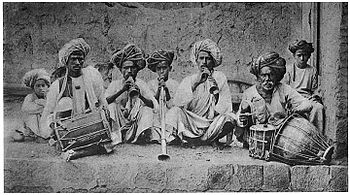The Maratha caste is composed of 96 clans, originally formed in the earlier centuries from the amalgamation of families from the peasant (Kunbi), shepherd (Dhangar), blacksmith (Lohar), carpenter (Sutar), Bhandari, Thakar and Koli castes in Maharashtra. Many of them took to military service in the 16th century for the Deccan sultanates or the Mughals. Later in the 17th and 18th centuries, they served in the armies of the Maratha Empire, founded by Shivaji, a Maratha Kunbi by caste. Many Marathas were granted hereditary fiefs by the Sultanates, and Mughals for their service.

Jyotirao Govindrao Phule was an Indian social activist, businessman, anti-caste social reformer and writer from Maharashtra. His work extended to many fields, including eradication of untouchability and the caste system and for his efforts in educating women and oppressed caste people. He and his wife, Savitribai Phule, were pioneers of women's education in India. Phule started his first school for girls in 1848 in Pune at Tatyasaheb Bhide's residence or Bhidewada. He, along with his followers, formed the Satyashodhak Samaj to attain equal rights for people from lower castes. People from all religions and castes could become a part of this association which worked for the upliftment of the oppressed classes. Phule is regarded as an important figure in the social reform movement in Maharashtra.The honorific Mahātmā, was first applied to him in 1888 at a special program honoring him in Mumbai.

Dalit, also some of them previously known as untouchables, is the lowest stratum of the castes in the Indian subcontinent. Dalits were excluded from the fourfold varna of the caste hierarchy and were seen as forming a fifth varna, also known by the name of Panchama. Several scholars have drawn parallels between Dalits and the Burakumin of Japan, the Baekjeong of Korea and the peasant class of the medieval European feudal system.
Deshastha Brahmin is a Hindu Brahmin subcaste mainly from the Indian state of Maharashtra and North Karnataka. Other than these states, according to authors K. S. Singh, Gregory Naik and Pran Nath Chopra, Deshastha Brahmins are also concentrated in the states of Telangana (which was earlier part of Hyderabad State and Berar Division), Andhra Pradesh and Madhya Pradesh (Which was earlier part of Central Provinces and Berar) Historian Pran Nath Chopra and journalist Pritish Nandy say, "Most of the well-known saints from Maharashtra, Karnataka and Andhra Pradesh were Deshastha Brahmins". The mother tongue of Deshastha Brahmins is either Marathi, Kannada or Telugu.
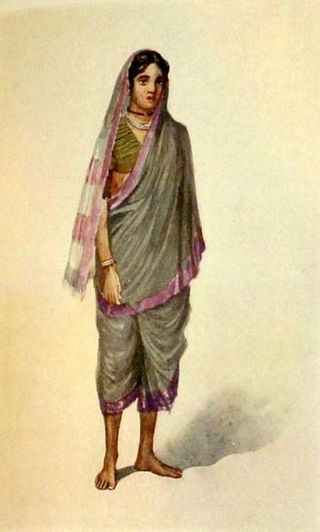
Mahar is a caste found largely in the state of Maharashtra and neighbouring areas. Previously they along with many other Hindu castes were treated as untouchables. The injustice of this practice was the primary reason for most of the Mahar community to follow B. R. Ambedkar in embracing Buddhism in the middle of the 20th century. There are still some Mahars who practice Hinduism.
PARDHI is a Hindu tribe in India. The tribe is found mostly in Maharashtra and parts of Madhya Pradesh however small numbers can be found in Gujarat and Andhra Pradesh. The word Pardhi is derived from the Marathi word ‘Paradh’ which means hunting and Sanskrit word ‘papardhi’ which means hunting or the game to be hunted. In some parts of India Pardhis are known as Meywarees. They also have various other names like Advichincher, Phans Pardhi, Phanse Pardhi, Langoli Pardhi, Bahelia, Bahellia, Chita Pardhi, Shikari, Takankar, Takia Pardhi. Pardhi tribe is divided in groups like Vaghri Pardhi and Phase Pardhi. These are further divided into subgroups like Pal Pardhi, Gav Pardhi, Takankar, Takari. Widely found surnames among them include Chauhan (Chavan), Rathod and Solanki.
The Dhangars are a herding caste of people found in the Indian states of Maharashtra, Karnataka, Goa, Madhya Pradesh and Uttar Pradesh. They are referred as Gavli in southern Maharashtra, Goa and northern Karnataka, Golla in Andhra Pradesh and Karnataka and Ahir in northern Maharashtra. Some Gavlis live in forested hill tracts of India's Western Ghats. Gavli, also known as Dange or Mhaske, and Ahir are a sub-caste of Dhangar. However, there are many distinct Gavli castes in Maharashtra and Dhangar Gavli is one of them.
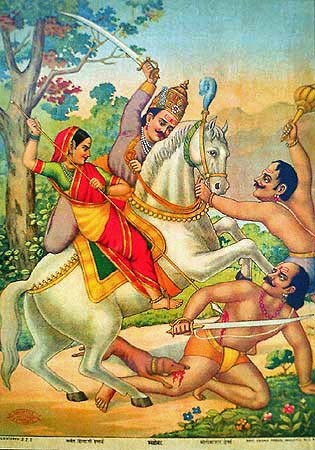
Khandoba, also known as Martanda Bhairava,, Malhari,Mylaralinga,Bandarada Odeya and Malhar, is a Hindu deity worshiped as a manifestation of Shiva mainly in the Deccan plateau of India, especially in the state of Maharashtra and North Karnataka. He is the most popular Kuladevata in Maharashtra. He is also the patron deity of some warrior, farming castes, 96 kulin kshatriya marathas,shepherd community and Brahmin (priestly) castes as well as several of the hunter/gatherer tribes that are native to the hills and forests of this region. The sect of Khandoba has linkages with Hindu and Jain traditions, and also assimilates all communities irrespective of caste, including Muslims. The form of Khandoba developed during the 9th and 10th centuries from a folk deity into a composite god possessing the attributes of Shiva, Bhairava, Surya and Kartikeya (Skanda). He is depicted either in the form of a linga, or as an image of a warrior riding on a bull or a horse. The foremost centre of Khandoba worship is the temple of Jejuri in Maharashtra. The legends of Khandoba, found in the text Malhari Mahatmya and also narrated in folk songs, revolve around his victory over demons Mani-malla and his marriages.

The Marathi people or Marathis are an Indo-Aryan ethnolinguistic group who are native to Maharashtra in western India. They natively speak Marathi, an Indo-Aryan language. Maharashtra was formed as a Marathi-speaking state of India on May 1, 1960, as part of a nationwide linguistic reorganisation of the Indian states. The term "Maratha" is generally used by historians to refer to all Marathi-speaking peoples, irrespective of their caste; However, it may refer to a Maharashtrian caste known as the Maratha.

The caste system in India is the paradigmatic ethnographic instance of social classification based on castes. It has its origins in ancient India, and was transformed by various ruling elites in medieval, early-modern, and modern India, especially in the aftermath of the collapse of the Mughal Empire and the establishment of the British Raj. It is today the basis of affirmative action programmes in India as enforced through its constitution. The caste system consists of two different concepts, varna and jati, which may be regarded as different levels of analysis of this system.
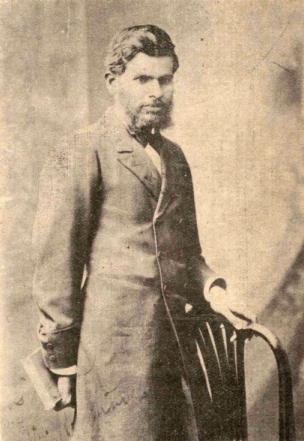
Vitthal Ramji Shinde was a social and religious reformer in Maharashtra, India. He was prominent among the liberal thinkers and reformists in India, prior to its independence. He has been recognised as a social reformer and an activist fighting for greater equality in Indian society. He is particularly noted for opposing the practice of 'untouchability', and for championing support and education for 'untouchables', such as Dalits.
Kamble is a Marathi Indian surname commonly used by communities residing in Maharashtra. The word "kamble" is literally translated as "cotton blankets" and could very well be derived from it; though there also existed clan, namely Sonkamble, and this could be its derivation, too.
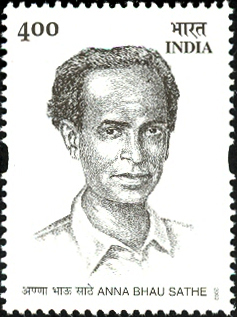
Dr. Tukaram Bhaurao Sathe, popularly known as Anna Bhau Sathe, was an Indian folk poet, writer, and social worker from the state of Maharashtra. Sathe was born into a Dalit, untouchable community, and his upbringing and identity were central to his writing and political activism. He is credited as a founding father of Dalit Literature and played vital role in Samyukta Maharashtra Movement. He was influenced by Chatrapati Shivaji Maharaj and wrote songs about him. He was one of early people from India who sung songs of Shivaji Maharaj crossing the boundaries of sea and land in Russia.
Marathi Brahmins are communities native to the Indian state of Maharashtra. They are classified into mainly three sub-divisions based on their places of origin, "Desh", "Karad" and "Konkan". The Brahmin subcastes that come under Maharashtra Brahmins include Deshastha, Chitpavan (Konkanastha), Saraswat, Karhade, and Devrukhe.
Gavli is a Hindu caste found in the Indian states of Maharashtra and Madhya pradesh. They a part of the Golla community.
The Ramoshi are an Indian aboriginal community found largely in Maharashtra, Madhya Pradesh, and Karnataka. They are classified as a Scheduled Tribe by the government of India.
Masoba is one of the folk guardian deities, a form of Lord Shiva, worshipped in some parts of India. His temples are found mainly in States of Maharashtra and Andhra Pradesh. Masoba is considered to be God of Spirit and temples are generally found near Smashan (cemeteries) or outside the village.
Religion in Maharashtra is characterised by the diversity of religious beliefs and practices.
Gopal Baba Walangkar, also known as Gopal Krishna, is an early example of an activist working to release the untouchable people of India from their historic socio-economic oppression, and is generally considered to be the pioneer of that movement. He developed a racial theory to explain the oppression and also published the monthly journal Vital-Vidhvansak, targeted at the Brahmanical Orthodoxy.
The Lokhande is a clan (Gotra) found amongst the Koli, Maratha, Mang, Mahar, Ramoshi, Brahmin, mainly in the state of Maharashtra in India but it also appears in Indian states bordering Maharashtra. Lokhande means the person who deals with iron or ironmonger.
